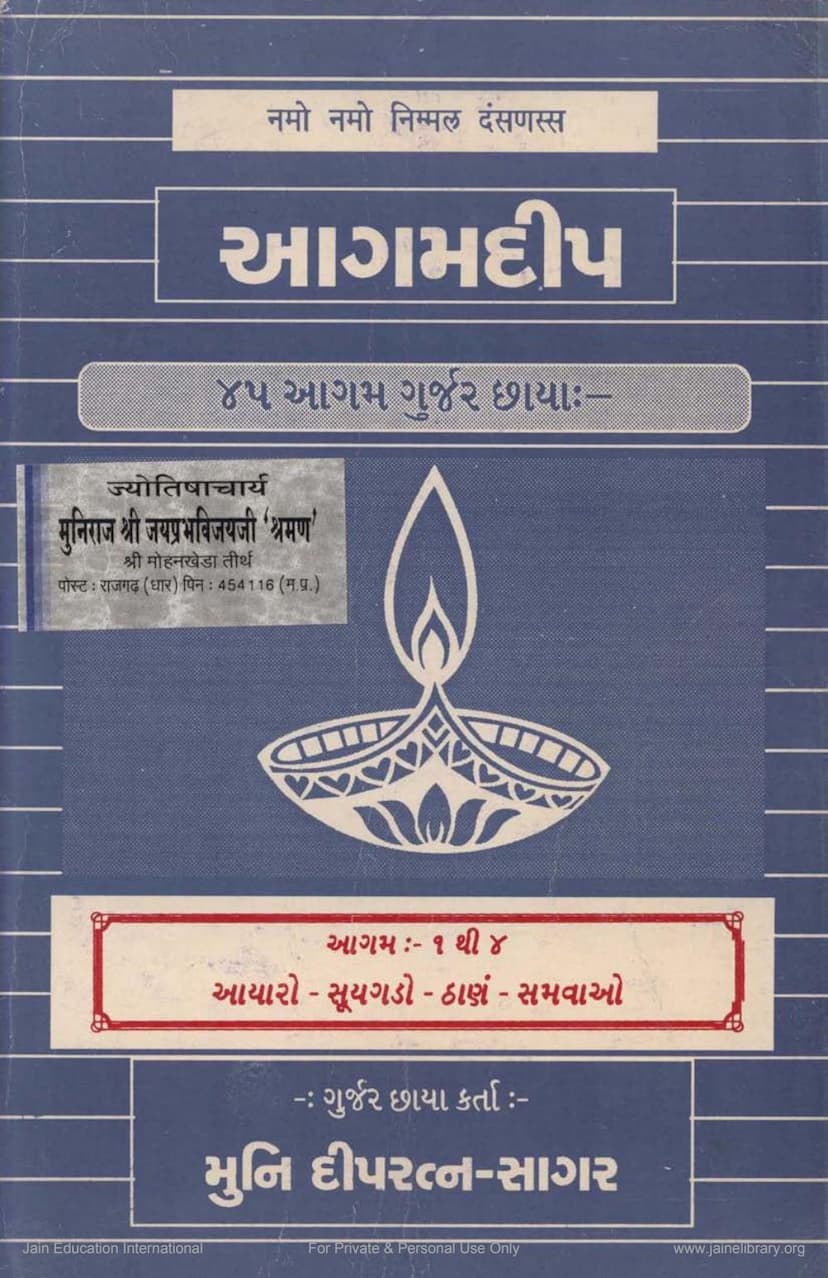Agam Deep 08 Antgadadasao Gujarati Anuvaad
Added to library: September 1, 2025

Summary
This document is the Gujarati translation and commentary of the Antagadadasao (also transliterated as Antagadadasao), which is the eighth Anga (part) of the Jain Agamas. The title of the work is "Agam Deep 08 Antgadadasao Gujarati Anuvaad," authored by Dipratnasagar and Deepratnasagar, and published by Agam Shrut Prakashan.
The provided text includes:
-
Title Page and Front Matter: Several pages (1-3) contain the title, author, publisher, dedications, acknowledgments to patrons and supporters, printing details (printer, typesetter), and pricing information. There are also table of contents-like pages (4-5) listing the "vargas" (sections/chapters) and their corresponding page numbers. Page 6, 7, and 8 list financial contributors and other Jain Agamic texts published by the same organization.
-
Content of Antagadadasao: The core of the text details the contents of the Antagadadasao. It systematically breaks down the text by "vargas" (classes/sections) and then by "adhyayana" (chapters/lessons) within each varga.
- Structure: The text outlines that the Antagadadasao has eight "vargas," each containing multiple "adhyayana."
- Narrative Style: The Antagadadasao primarily narrates the stories of individuals who attained liberation (siddha pada) through various austerities and disciplines. These stories often involve:
- Historical and Mythological Setting: The narratives are set in ancient cities like Champanagari and Dwarika, often mentioning prominent figures like Lord Krishna, Baldev, and various kings and princes.
- Past Lives and Karmic Rebirths: The stories frequently trace the individuals' past lives, highlighting how karmic actions in previous births influenced their current circumstances and eventual liberation.
- Austerities and Ascetic Practices: A significant focus is placed on the intense austerities, fasts (like shashthabhakta, ashtamabhakta), and vows undertaken by these individuals to purify their souls and achieve liberation. Various specific types of penances are described, such as the "Ratnavali Tap," "Kanakavali Tap," "Kshullaka Simhanishkrida Tap," "Maha Simhanishkrida Tap," "Saptasamika," "Ashtamashtamika," "Navanavamika," "Dash Dashamika," "Muktaavali Tap," and "Ayambil Vardhaman Tap."
- Moral and Spiritual Teachings: Through these narratives, the text imparts moral lessons and spiritual guidance on topics such as renunciation, detachment, karma, perseverance in spiritual practice, and the ultimate goal of liberation from the cycle of birth and death.
- Examples of Narratives:
- Varga 1: Features stories of individuals like Gautam Kumar, who renounced worldly pleasures to become a disciple of Lord Arishtanemi.
- Varga 2: Continues with similar narratives.
- Varga 3: Details the stories of numerous princes and individuals, including Jalikumar, Malikumar, Purushasen, Valin, Pradyumna, Shamb, Aniruddha, Satyant, and Dridhanemi, all of whom attained liberation after significant spiritual practices. The story of Gajsukumar is elaborated upon, including his renunciation and a significant incident with the Yaksha Mudgar Pani, and his subsequent attainment of Keval Gyan. The story of Somil Brahman, who caused the death of Gajsukumar, is also recounted.
- Varga 4 & 5: Continue with the lives and spiritual journeys of various individuals, often princes and queens, emphasizing their renunciation and austerities.
- Varga 6: Focuses on householders (Gathapatis) like Mankati, Kinkarma, Mudgarpani, Kashyap, Kshemak, Vritidhar, Kailash, Harichandan, Vara, Sudarshan, Purnabhadra, Sumanbhadra, Supratisthita, Megh, and Atimukta, detailing their paths to liberation through severe penances. The story of Arjun Mali and his encounter with the Mudgarpani Yaksha is a prominent example.
- Varga 7: Describes the lives of queens of King Shrenik, such as Nanda, Nandavati, Nandottar, Nandashrenika, Maruta, Sumaruta, Mahamaruta, Maruta, Devi Bhadra, Subhadra, Sujata, Sumantika, and Bhutadatta, who all renounced worldly life and attained liberation.
- Varga 8: Focuses on the stories of ten queens of King Kunika and Shrenika, including Kali, Sukali, Mahakali, Krishna, Sukrishna, Mahakrishna, Vir Krishna, Ram Krishna, Pitrusen Krishna, and Mahasen Krishna. Their lives are characterized by rigorous penances and the practice of various bhikshu pratimas (ascetic practices) and tapas (austerities).
-
Overall Purpose: The book serves as a commentary and translation to make the teachings of the Antagadadasao accessible in Gujarati. It aims to educate readers on the lives of great souls who achieved liberation, highlighting the importance of renunciation, spiritual discipline, and karma in the Jain path to salvation. The translation and commentary are attributed to Muni Dippratna Sagar.
The text provides a detailed, verse-by-verse (or rather, adhyayana-by-adhyayana) explanation of the original Jain scripture, making it a valuable resource for understanding the spiritual lives and exemplary paths to liberation described in the Antagadadasao.